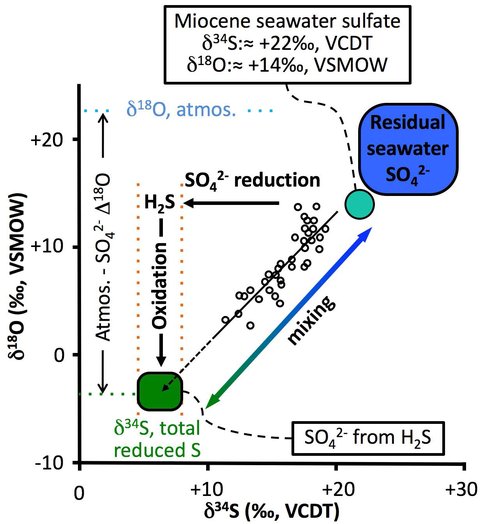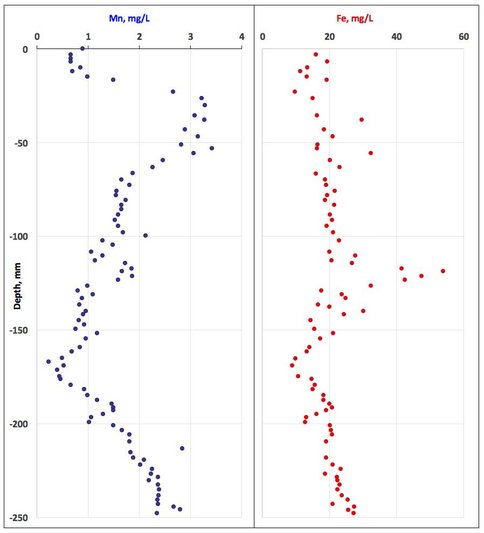2015 Annual Science Report
 University of Wisconsin
Reporting | JAN 2015 – DEC 2015
University of Wisconsin
Reporting | JAN 2015 – DEC 2015
Project 2D: Carbonate-Associated Sulfate (CAS) as a Tracer of Ancient Microbial Ecosystems
Project Summary
Our aim is to investigate and understand microbial communities that flourished much earlier in the Earth’s history. We have adapted a method used to investigate the isotopic compositions of ancient oceans, by analyzing rocks formed at those times, but applied it to the pore-waters present in ancient sediments inhabited by in the contemporaneous microbial communities. The isotopic compositions we measure tell us about the extent and progress of microbial metabolic processes. We have applied this method very successfully to 12 million year old sediments. Most recently in order to test and calibrate the approach most fully, we have been examining recent deposits in which we can analyze microbiological communities, the pore-waters in which they live and the rocks forming there.
Project Progress
During the year we have continued further, and more sophisticated, analyses of the carbonate associated sulfate (CAS) extracted from carbonate nodules and phosphatic beds of the Miocene Monterey Shale. The previously-reported exciting results on Monterey Shale CAS were serendipitous in that those examples were chosen just to test the new extraction method that we had developed (Theiling and Coleman, 2015). We started applying the method to the samples collected in the UK fieldwork completed in 2014. We collected Early Jurassic age calcite nodules from the Jet Rock formation (Yorkshire) and very recently formed iron carbonate concretions (Warham saltmarsh, Norfolk). The Recent site is very important since the process of concretion formation is going on at the moment and allows us to validate the interpretation of past microbial ecosystems and their environments deduced from chemical, mineral and isotopic analyses.
Last year we analyzed the CAS samples for δ18O and δ34S and were able to hypothesize a mixing relationship between two and members: marine sulfate and sulfate produced by microbial oxidation of sulfide (Theiling and Coleman, 2016). For the latter, we constrained its δ34S value by analyzing the composition of the residue left after dissolution of carbonate to extract CAS and calculated its δ18O by assuming that Miocene atmospheric oxygen had the same value as now and applied the fractionation factor we had measured from microbial oxidation of pyrite experiments. These two values reassuringly fell perfectly on the extrapolated mixing line, thus confirming the concept.
More recently we took some of the same samples but measured δ17O and δ18O. In this case it is not the absolute values but the relationship between the two and deviation (Δ17O) is from the terrestrial fractionation line which relates them. The new data are shown in Figure 2. For comparison the other data included in the plot are from sulfate produced by recent oxidation of sulfide at Río Tinto, Spain.
We believe the difference in slopes of the two datasets may be significant and might relate to different processes of sulfide oxidation; Río Tinto mainly has abiotic oxidation by ferric iron where the oxygen comes solely from water. We are investigating this further.
We used our new method for CAS extraction on the newly collected samples.
The first part of the process involves leaching to remove non-structural sulfate. This process was repeated until the leachate contains no sulfate, and in both cases many repetitions were needed, which extended the preparation time and reduced sample throughput. The initial results from the Jet Rock concretions are puzzling as they do not show the values more positive than seawater composition that we were expecting.
A gel probe consists of a long strip of polyacrylamide gel supported on a plexiglass rod (Zhang et al., 2002). When inserted into sediment the pore waters equilibrate with the gel. Subsequently, the gel is cut into successive small portions from which the porewater constituents can be extracted and analyzed by ICP or ICPMS. In this way we measured extremely high resolution porewater geochemistry profiles in the Warham saltmarsh mud. One exciting example of the results is shown in Figure 4.
As sediments are buried successive microbial processes oxidize organic matter (Froelich 19xx) and mineral biosignatures provide a durable record of them (Coleman, 1985). In this profile we can see a peak of dissolved Mn from 25 to 55 mm depth resulting from reduction of solid phase manganese oxides. This is followed at 55 mm by a pronounced spike of dissolved iron from iron reduction. Furthermore, both Fe and Mn dropped dramatically at a depth of about 170 mm. After removing the probe we found a siderite nodule at that depth, which clearly had drawn down both cations. These data confirm our general understanding at this site of which microbes and which metabolisms are operating.
References
Coleman M. L. (1985) Geochemistry of diagenetic non-silicate minerals: kinetic considerations. Phil. Trans. Roy. Soc. A 315, 39-56.
Froelich P. N., Klinkhammer G. P., Bender M. L., Luedtke N. A., Heath G. R., Cullen D., Dauphin P., et al. (1979) Early oxidation of organic matter in pelagic sediments of the eastern equatorial Atlantic: suboxic diagenesis. Geochimica et Cosmochimica Acta 43, 1075-1090.
Theiling BP and Coleman M (2015) Refining the extraction methodology of carbonate associated sulfate: Evidence from synthetic and natural carbonate samples. Chem. Geol. 411 36–48. http://dx.doi.org/10.1016/j.chemgeo.2015.06.018.
Theiling BP and Coleman M (2016) Microbial consumption of mid-Miocene ‘missing’ buried organic carbon. Geology (in revision).
Zhang H., Davison W., Mortimer R. J. G., Krom M. D., Hayes P. J., and Davies I. M. (2002) Localised remobilization of metals in a marine sediment. Science of The Total Environment 296, 175-187.
Publications
-
Theiling, B. P., & Coleman, M. (2015). Refining the extraction methodology of carbonate associated sulfate: Evidence from synthetic and natural carbonate samples. Chemical Geology, 411, 36–48. doi:10.1016/j.chemgeo.2015.06.018
-
PROJECT INVESTIGATORS:
-
PROJECT MEMBERS:
Bethany Theiling
Co-Investigator
James Boles
Collaborator
Robert Mortimer
Collaborator
Issaku Kohl
Unspecified Role
Edward Young
Unspecified Role
-
RELATED OBJECTIVES:
Objective 5.2
Co-evolution of microbial communities
Objective 6.1
Effects of environmental changes on microbial ecosystems
Objective 7.1
Biosignatures to be sought in Solar System materials




